Blogs
March 20, 2024
CCQI scores for IFM projects point to substantial integrity risks
The Carbon Credit Quality Initiative (CCQI) has released new scores for the integrity risks of carbon credits from improved forest management (IFM) projects. We find that unrealistic baselines and underestimated leakage are likely to lead to significant overestimation of emission reductions or removals under all assessed methodologies. The likelihood of additionality depends strongly on the forest management practices that are implemented. The sustainable development benefits are more limited compared to most other project types.
By Lambert Schneider (Oeko-Institut), Felix Fallasch (Oeko-Institut), Isabel Haase (Oeko-Institut), Hannes Böttcher (Oeko-Institut), Tani Colbert-Sangree (GHG Management Institute), Olga Lyandres (GHG Management Institute), Nora Wissner (Oeko-Institut), Cristina Urrutia (Oeko-Institut), Ankita Karki (Oeko-Institut), Rowan Alusiola, Sophia Lauer (Oeko-Institut), Pedro Barata (Environmental Defense Fund), Darcy Jones (Environmental Defense Fund), Morgan Bomer (Environmental Defense Fund), Olivia Polkinghorne (Environmental Defense Fund).
The basic idea of improved forest management (IFM) projects is simple: forest owners are rewarded for implementing management practices that enhance carbon stocks. Putting a price on carbon can provide the economic incentives to implement such practices. Improved forest management is also a climate mitigation measure that has significant scaling potential. Globally, planted forests cover more than 500 million hectares, and naturally regenerating forests with some form of management even cover more than 2 billion hectares.1 In practice, however, we find that this project type has high integrity risks and differs in various ways from other project types.
What is an IFM project?
IFM projects can entail a broad range of activities, including reducing or stopping harvesting, reduced impact logging, thinning, or enrichment planting, among others. Which of these activities are implemented on the ground is often unclear, however. Project design documents often list various general activities, and sometimes identical descriptions are used by different projects. In contrast to most other project types, carbon crediting programs commonly do not require project developers to monitor and document which activities are actually being implemented. Rather, projects can claim credits if carbon stocks are higher than a hypothetical baseline, regardless of whether the envisaged forest management activities were implemented.
Getting carbon credits from producing less timber
IFM projects also differ from most other carbon projects as they can earn carbon credits from producing less timber. In carbon markets, a well-established principle is that projects should provide the same level of service as in the baseline scenario. Project developers cannot get carbon credits from shutting down a cement plant without building a new one, for example. This principle is not applied to IFM projects in which emission reductions may largely accrue from reduced harvesting. This poses high risks for leakage; carbon stocks may be enhanced in one place at the expense of causing emissions at other places as the timber may need to be produced elsewhere.
Mixed picture on additionality
Assessing the additionality of IFM projects is very challenging. Whether an activity needs carbon credits to be implemented depends on many factors: the tree species, the geographic location, or market conditions. Carbon credits are only one variable among many others. We find that the likelihood of additionality depends strongly on the type of activities implemented by projects. Some activities, such as increasing forest productivity, may sustain or even increase revenue from timber production. By contrast, stopping timber production in a forest and instead managing it for conservation is likely to be additional as the project developers no longer have revenues from timber production.
For some activities, such as extending rotation age, the likelihood of additionality varies. In theory, these projects could be additional: revenues from carbon credits can compensate forest owners for delaying harvesting beyond the economically optimal point in time. In practice, many other factors, such as fluctuating timber prices, may influence the timing of harvests. For projects that extend the rotation age by only a few years, it would be very difficult to assess whether such increases are driven by exogenous factors or carbon revenues. For projects with longer extensions of the rotation cycle, additionality is more likely.
Accounting for carbon: carbon pools and emission sources in IFM projects
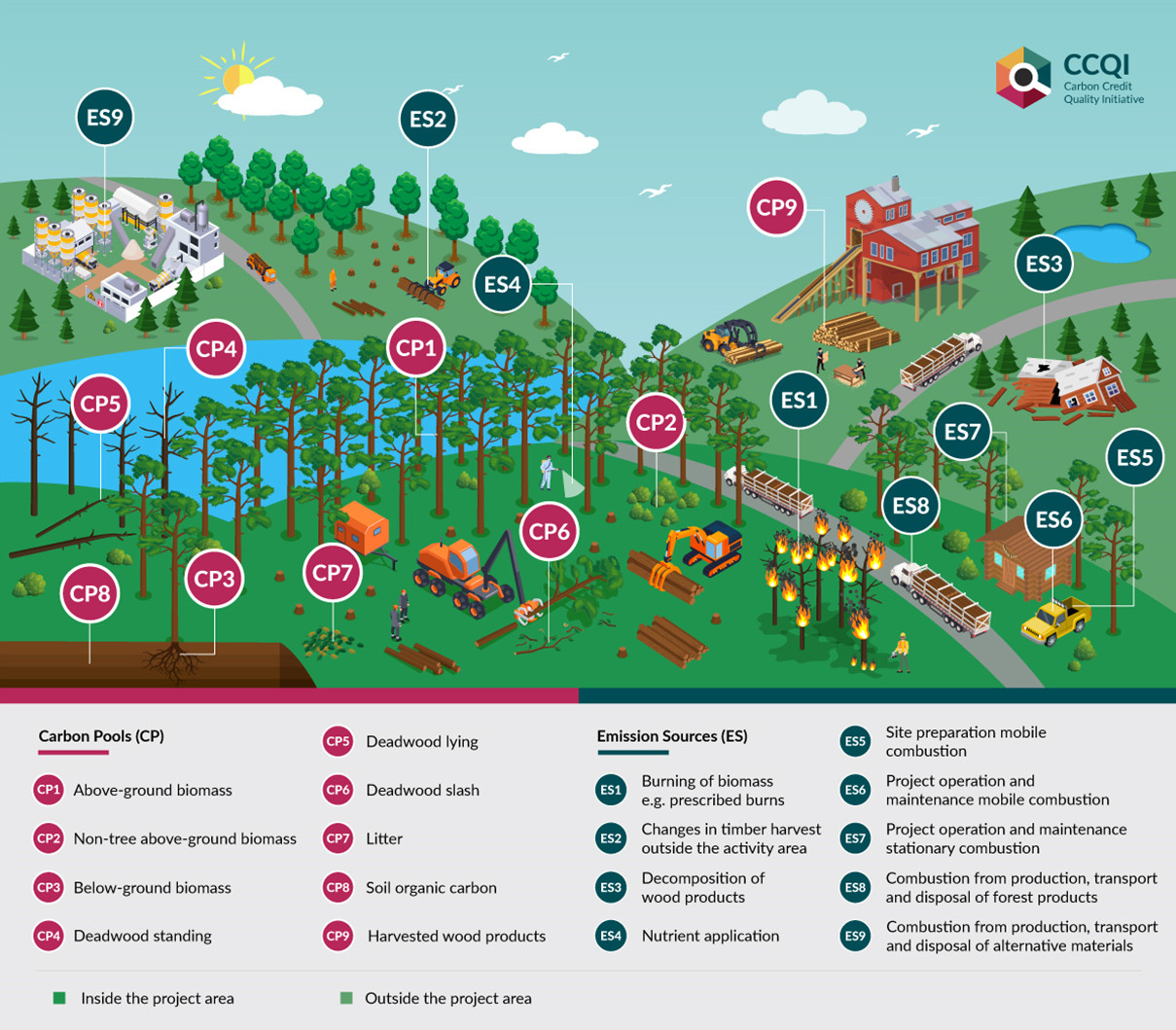
Unrealistic baselines
Establishing baselines for IFM projects is associated with high uncertainties. How the management of a forest would evolve over a period of up to 100 years without carbon credits is very hard to predict. This can be affected by many unforeseeable developments: new policies could incentivize enhanced carbon storage (e.g., as part of strategies to enhance removals) or put increased pressure on forests (e.g., by promoting the use of biomass). Timber prices can change over time and climate change may affect future forest management. The impact of these exogenous factors on forest carbon stocks could potentially be much larger than the impact of carbon credits. This challenge is sometimes referred to as a "signal-to-noise issue": depending on how exogenous factors develop over time, the emission reductions or removals may be hugely under- or overestimated.
None of the assessed methodologies appropriately accounts for this uncertainty. By contrast, we find that methodologies often provide project developers with considerable flexibility in determining baseline carbon stocks. This allows project developers to pick the approaches that result in lower baseline carbon stocks and hence more carbon credits. For example, many projects registered under the California Air Resources Board (CARB) received carbon credits while their forest management practices did not differ from control groups that did not receive carbon credits.2 Overall, the current methodological approaches for establishing baselines are likely to lead to significant overestimation of emission reductions or removals.
Unaccounted leakage
Since IFM projects may reduce harvest levels, they are exceptionally prone to leakage risks compared to other project types. As with baselines, leakage is associated with considerable uncertainties. Leakage rates reported in the literature vary, depending on geography, forest types, and other factors. We find that carbon crediting methodologies do not appropriately account for this risk. The leakage rates assumed in IFM methodologies (often around 20%) are much lower than in the scientific literature (often around 80%). Moreover, some forms of leakage are not accounted for at all. None of the IFM methodologies accounts for international leakage, but trade of timber does not necessarily stop at national borders. Similarly, methodologies do not account for leakage stemming from the increased production of substitution materials, such as plastics or cement. And some methodologies do not apply a leakage deduction at all if harvest levels decrease by a smaller degree. For these reasons, leakage is likely to be significantly underestimated.
Limited sustainable development benefits
Sustainable development impacts vary depending on the activities implemented within an IFM project. Generally, IFM projects impact only a limited number of sustainable development goals (SDGs), namely SDG 2 (zero hunger), SDG 6 (clean water and sanitation), SDG 8 (decent work and economic growth) and SDG 15 (life on land). For example, shifting from timber production to conservation can strongly contribute to SDG 6 and SDG 15, whereas reduced impact logging has small positive impacts on a few SDGs. By contrast, increasing the productivity of timber production is likely to have an overall negative impact on sustainable development.
Is IFM well-suited for carbon crediting?
Our evaluation shows that the quantification of emission reductions or removals bears the largest integrity risks for IFM projects. We find that all assessed quantification methodologies are likely to lead to significant overestimation. Indeed, quantifying the emissions impact of IFM activities raises fundamental methodological challenges, due to the uncertainty associated with establishing baselines and the “signal-to-noise” issues this raises as well as the large leakage risks if timber production is reduced. For most IFM activities, these challenges are very difficult, if not impossible, to overcome. Therefore, IFM may be better promoted through policies such as subsidies or fiscal incentives rather than carbon crediting.
-
- Lesiv, M., Schepaschenko, D., Buchhorn, M. et al. Global forest management data for 2015 at a 100m resolution. Sci Data 9, 199 (2022). https://doi.org/10.1038/s41597-022-01332-3
-
- Stapp, J., Nolte, C., Potts, M. et al. Little evidence of management change in California's forest offset program. Commun Earth Environ 4, 331 (2023). https://doi.org/10.1038/s43247-023-00984-2
- Coffield, Shane R.; Vo, Cassandra D.; Wang, Jonathan A.; Badgley, Grayson; Goulden, Michael L.; Cullenward, Danny et al. (2022): Using remote sensing to quantify the additional climate benefits of California forest carbon offset projects. In Global change biology 28 (22), pp. 6789-6806. https://doi.org/10.1111/gcb.16380
May 11, 2023
Cooking up Quality: Carbon credits from efficient cookstove projects face integrity issues worth fixing
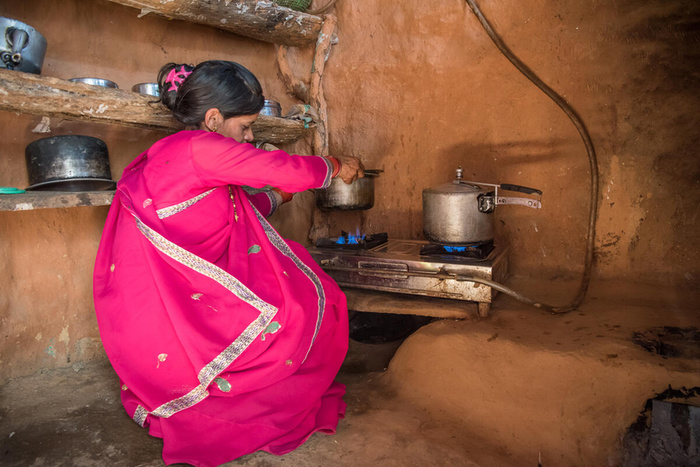
Cookstove projects are gaining interest on the voluntary carbon market – they make up about 15% of the current project pipeline . In this blog, we unpack their integrity risks based on our evaluations under the Carbon Credit Quality Initiative (CCQI) and Calyx Global. We find that while switching to efficient cookstoves can have substantial sustainable development benefits and is likely an additional mitigation activity, under current carbon crediting rules the project type comes with significant risks regarding the quantification of emission reductions, non-permanence and double counting. Addressing these integrity issues is critical to provide the assurances of high integrity that these projects deserve.
By Lambert Schneider (Oeko-Institut), Annelise Gill-Wiehl (UC Berkeley/Calyx Global), Isabel Haase (Oeko-Institut), Gustavo Andrade Reginato (Calyx Global), Linda Rivera Macedo (Calyx Global), Donna Lee (Calyx Global), Randall Spalding-Fecher (Carbon Limits), Felix Fallasch (Oeko-Institut), Nora Wissner (Oeko-Institut), Anne Siemons (Oeko-Institut), Derik Broekhoff (Stockholm Environment Institute), Pedro Martins Barata (Environmental Defense Fund), Darcy Jones (Environmental Defense Fund), John Holler (World Wildlife Fund, US)
Worldwide, 2.4 billion people still do not have access to clean cooking, contributing to the premature death of 4.3 million people each year through indoor air pollution. Efficient cookstoves can improve the quality of life of people most in need, by reducing fuel expenses, the time needed to collect firewood - often a woman or child's task, and indoor air pollution. Efficient cookstoves also reduce pressure on forests by having households use less biomass, leading to higher carbon reservoirs and fewer emissions.
Overall, Calyx Global finds that efficient cookstove projects have high potential to contribute to SDGs due to their direct interaction and impact with communities and the environment. Calyx Global's assessments of 50 projects found that a large majority have monitored and verified their SDG contributions, largely under the Gold Standard for the Global Goals. The most common SDG contributions reported and verified by a third-party auditor are poverty reduction (SDG 1), improved health (SDG 3), access to modern energy and increased energy efficiency (SDG 7), enhancement of job opportunities (SDG 8) and sustainable forest management (SDG 15).
This makes cookstove projects a promising mitigation option, and a popular project type in the voluntary carbon market. However, our research and evaluations show that their climate benefits are often overstated.
Emission reductions are very likely overestimated
CCQI's evaluations suggest that emission reductions from cookstove projects in rural areas are likely to be 'additional', i.e. they would not have happened at the same scale without the incentive from carbon credits. Efficient cookstoves are often unaffordable for households in rural areas in developing countries. Revenues from carbon markets allow project developers to subsidize efficient cookstoves or distribute them for free, thus removing a key barrier for their market uptake.
Calyx Global's assessments support the CCQI analysis. They indicate that well over 80% are likely to be additional (i.e., projects have low or low-medium risk of non-additionality).
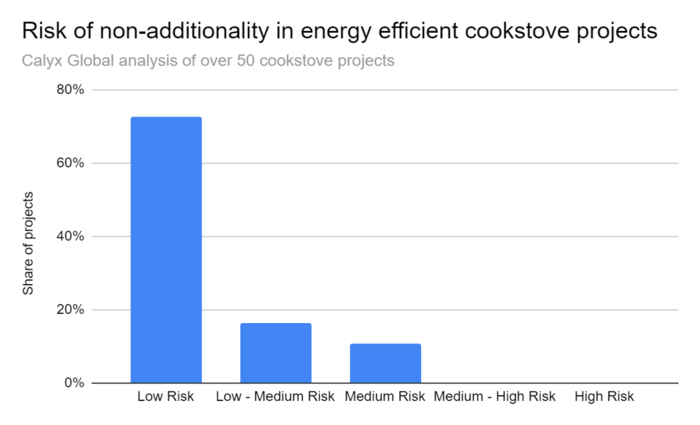
While additionality is necessary to ensure integrity, it alone is not sufficient. The main problem with the integrity of credits from cookstove projects lies elsewhere: the calculated emissions reductions are very likely overestimated.
The root of the issue lies in the carbon crediting program's quantification methodologies that project developers use to calculate the emission reductions of their projects. To understand where exactly things go wrong, one needs to dissect how these methodologies quantify emission reductions. The basic approach is straightforward: the methodologies compare the amount of wood or charcoal consumed before and after installing the efficient cookstoves. The devil, however, lies in the details.
In all quantification methodologies assessed by CCQI, the largest factor skewing the calculations is the fraction of non-renewable biomass (fNRB). This is the fraction of biomass used in cookstoves that is assumed not to regrow, and thus leads to the depletion of biomass carbon stocks, such as in trees or shrubs. The higher this factor is, the more carbon stocks are assumed to be depleted and the larger the calculated emission reductions. There is a large discrepancy between the fNRB values used by voluntary carbon market projects to calculate emission reductions (typically above 80%) and the modeling results of independent researchers based on satellite data (globally about 30% on average). This factor alone could lead to an overestimation of emission reductions by up to several hundred percentage points. This risk arises because estimating fNRB is associated with significant uncertainties and the quantification methodologies provide project developers a lot of flexibility in how to derive their own fNRB value. To address this issue, CCQI recommends that carbon crediting methodologies prescribe using conservative default values for fNRB. These values should be derived from the literature and be specific to the region of the project to reflect the significant geographical differences in these values.
Next to the fraction of non-renewable biomass, there are several other parameters in the emissions quantification equation where assumptions and/or poor data can distort the results. These include: how much firewood people consume on average before project implementation, the degree to which people use the new cookstoves, if they continue to use their old cookstove next to the new one ('stove stacking'), if they cook more due to the new cookstove ('rebound effect'), how the efficiency of both the baseline and project cookstoves is determined, and how the amount of wood needed to produce one kilogram of charcoal is estimated. For each of these parameters, the risk of overestimation varies by the respective provisions of the methodology, but in aggregate these factors can also contribute to significant overestimation of emission reductions. New research indicates that, among the available quantification methodologies, Gold Standard's recent Metered and Measured methodology involves lower risks of overestimation. CCQI and Calyx Global have not yet assessed this methodology.
Calyx Global's assessment of cookstove projects supports the likely overestimation of emission reductions. Calyx evaluates projects' emission reductions based on fNRB, how the amount of firewood and charcoal used before and during the project is established, and how project stove and baseline stove use is monitored throughout the project. Our results align with CCQI's analysis as we find that 70% of reviewed energy efficient cookstove projects have a 'high risk' of overestimated emission reductions, meaning that their calculated emission reductions are likely to be at least 80% greater than (i.e., almost twice as high as) Calyx Global's estimate of the likely emission reductions.
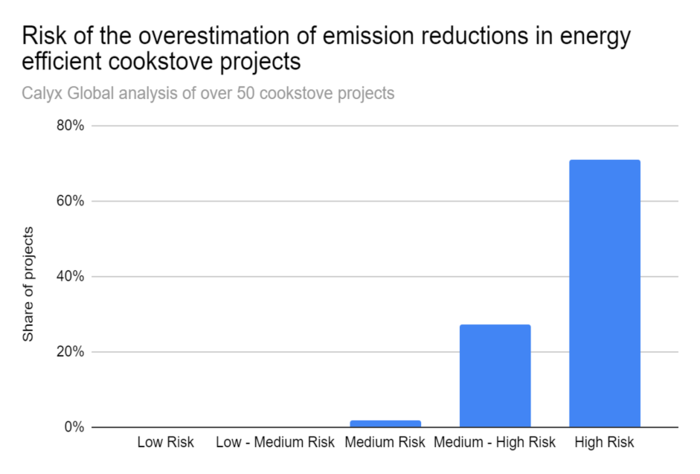
Non-permanence risks are unaddressed
Besides overestimation, there is also the risk that the emission reductions from cookstove projects are not permanent. Efficient cookstoves preserve carbon stocks in forests or other land areas. Forests are, however, inherently in jeopardy of being destroyed or degraded, and thus releasing the stored carbon back into the atmosphere, for example through land conversion or wildfires. Therefore, the effects of the projects might be reversed. In contrast to forestry projects, none of the carbon crediting programs assessed by CCQI and Calyx Global currently addresses this risk for cookstove projects.
Non-permanence is a risk for all cookstove projects. However, an advantage of cookstove projects is that they directly address a deforestation driver and hence can have a direct impact on carbon forest stocks, whereas the impact of some forestry projects on carbon stocks is more indirect, for example when they focus on capacity building. Moreover, the reversal risk varies between projects, depending on factors such as when the surrounding forests would be depleted at current deforestation rates.
Calyx Global evaluated the non-permanence risk of individual projects based on the extent of the relevant tree canopy or forest and the estimated depletion rate of the carbon in that relevant forest, and found a significant percentage of projects with medium to high risk of non-permanence.
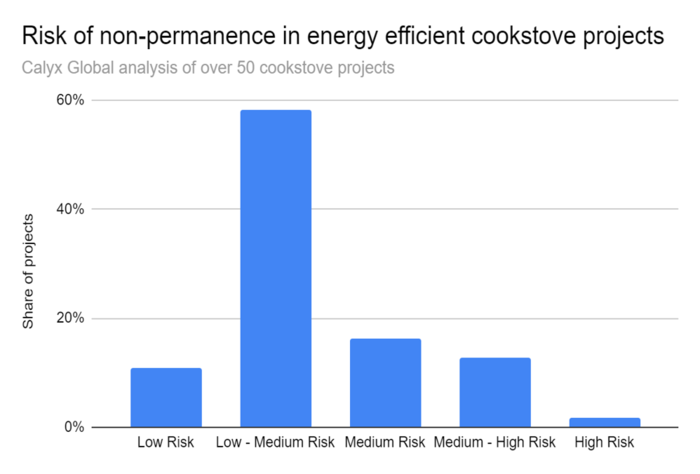
Cookstove projects and forestry projects might claim the same emission reductions
Another blind spot in current carbon crediting programs' rulebooks is 'double issuance' due to overlapping claims between cookstove and forestry projects. Double issuance means that programs issue credits for the same emission reductions to two different projects. This can happen when a cookstove and a forestry project operate in the same area. By reducing the use of non-renewable biomass, the cookstove project claims emission reductions from preserving carbon stocks in nearby forests. These same emission reductions might also be claimed by a project to reduce emissions from deforestation of forest degradation (REDD). If there is no systematic check whether project areas of efficient cookstoves project overlap with forestry projects, carbon crediting programs might issue carbon credits twice for the same emission reductions. CCQI and Calyx Global found that none of the carbon crediting programs have rules to systematically check for such overlaps.
Calyx Global found that more than half of energy efficient cookstove projects are co-located in areas where projects claim emission reductions from protecting forests, such as REDD projects. Though it is difficult to know whether the emission reduction claim is actually overlapping, double issuance is a risk for these projects.
Cookstove projects can become high-quality, high-impact emission reduction projects if carbon crediting programs substantially improve their rules
Efficient cookstove projects can greatly improve the living conditions of communities and help reduce the drivers of deforestation. And these projects are in need of funding. However, carbon crediting programs need to significantly improve their current rules to ensure that the climate impact of these projects is not overstated. Methodologies must be revised to ensure that emission reductions are quantified conservatively. Some programs, such as the Gold Standard, have already strengthened some provisions, and others, such as Verra, are currently revising their methodology.
But further revisions are needed. For parameters that are associated with significant uncertainty and flexibility, such as the fraction of non-renewable biomass, methodologies could prescribe region-specific, conservative default values. Programs should also account for the risk of non-permanence and establish provisions to avoid double issuance. One possible solution could be to 'nest' cookstove projects under forestry projects that cover the same land areas. To ensure a level-playing field, it is important that all carbon crediting programs make these changes, as otherwise project developers could have incentives to pick the program and methodology under which they can generate the most carbon credits.
The necessary revisions will lead to fewer carbon credits being issued to these projects. To cover the costs of the projects, buyers will thus need to pay more for each carbon credit. But these projects are well worth a higher price and may only continue to attract funding if the integrity issues are resolved. Addressing these integrity issues is therefore critical to achieve both the climate and non-climate benefits that energy efficient cookstove projects can bring.